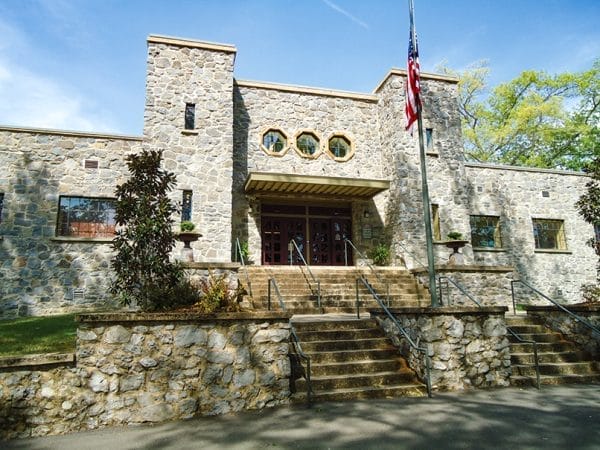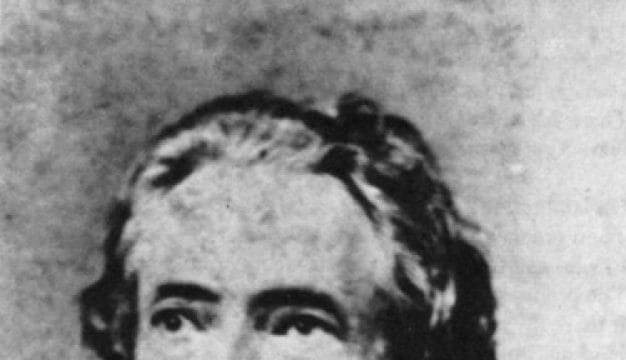Guntersville Museum & Cultural Center
The Guntersville Museum & Cultural Center houses numerous collections related to the history of Guntersville, Marshall County, and the surrounding area, focusing on Native Americans, prominent citizens, and Guntersville Lake and Dam. The museum also has several collections of wildlife art and mounted birds native to the region as well as temporary exhibits. In recent years, it has garnered accolades for its fine arts collection, national exhibits, and local special event exhibits.
 Guntersville Museum & Cultural Center Entrance
The museum is housed in a former armory that was built in 1936 for Company E, 167th Infantry Division by the Works Progress Administration. The building, a castle-like limestone structure with walls more than a foot thick, was used for drills, training, and classroom instruction. During war time, the space was used for social functions and dances, as a meeting place for scout troops, and for parties during the town’s annual boat races. Local schools have used the building to hold fundraisers and to construct homecoming parade floats. The armory also housed the Guntersville Fire Station from the mid-1970s until the mid-1980s. The building was listed on the National Register of Historic Places in 2005 and extensively renovated. Today, it houses a number of permanent exhibits.
Guntersville Museum & Cultural Center Entrance
The museum is housed in a former armory that was built in 1936 for Company E, 167th Infantry Division by the Works Progress Administration. The building, a castle-like limestone structure with walls more than a foot thick, was used for drills, training, and classroom instruction. During war time, the space was used for social functions and dances, as a meeting place for scout troops, and for parties during the town’s annual boat races. Local schools have used the building to hold fundraisers and to construct homecoming parade floats. The armory also housed the Guntersville Fire Station from the mid-1970s until the mid-1980s. The building was listed on the National Register of Historic Places in 2005 and extensively renovated. Today, it houses a number of permanent exhibits.
The Guntersville Museum & Cultural Center was founded in 1990 when the city appointed a 15-member board of directors to establish and maintain a non-profit museum and cultural center dedicated to the preservation and interpretation of Guntersville’s culture and history. The museum was originally housed in the vacant Episcopal Church. The museum outgrew that location and moved into the nearby armory in 2007.
 Guntersville Museum Artifacts
The popular Native American Room is a permanent exhibit that displays artifacts from the Percy Barnard Collection. Some of the items date to the Paleoindian Period, more than 10,000 years ago, and include projectile points, pots, tools, beads, and body ornaments. The pieces were collected by Barnard, who had become interested in collecting artifacts about the time he sold his home to the Tennessee Valley Authority in anticipation of the construction of the Guntersville Dam in 1935. He was largely self-taught and collected books and artifacts relating to local Native American culture. After 40 years of collecting in the area, he had acquired approximately 4,000 items that he showcased in his home. Upon his death, Percy Barnard’s son, H. V. Barnard, donated the collection to the Guntersville Museum.
Guntersville Museum Artifacts
The popular Native American Room is a permanent exhibit that displays artifacts from the Percy Barnard Collection. Some of the items date to the Paleoindian Period, more than 10,000 years ago, and include projectile points, pots, tools, beads, and body ornaments. The pieces were collected by Barnard, who had become interested in collecting artifacts about the time he sold his home to the Tennessee Valley Authority in anticipation of the construction of the Guntersville Dam in 1935. He was largely self-taught and collected books and artifacts relating to local Native American culture. After 40 years of collecting in the area, he had acquired approximately 4,000 items that he showcased in his home. Upon his death, Percy Barnard’s son, H. V. Barnard, donated the collection to the Guntersville Museum.
The Wyeth Room is dedicated to members of the Wyeth family, who were early settlers of Guntersville. Featured is John Allan Wyeth (1845-1922), a nationally acclaimed surgeon and an early president of the American Medical Association who also invented the first surgical table that was manufactured in Guntersville. The original table is on display in the Wyeth Room, along with an extensive genealogy of the family.
Guntersville Museum also houses an extensive gem collection, items relating to the history of the John Gunter family, and an exhibit on the Tennessee Valley Authority and the construction of Guntersville Dam. The museum also displays archival photos of steamboats, families, and homes of the late 1800s, as well as early Guntersville businesses, schools, and churches. The Errol Allen/Sonny Lewis Exhibit Hall showcases along its walls poster-sized old photos depicting Guntersville’s history. They collection was donated by the late Ray Hubble, a long-time member of the board of directors.
 Guntersville Museum Artworks
The fine arts collection includes original artwork by Guntersville natives Frank Nelson, internationally known Nall (pseudonym of Fred Nall Hollis), folk artist Michael Banks, and the late Charles “C. E.” Monroe, one of the nation’s foremost wildlife and magazine cover artists of the 1950s and 1960s. The museum also hosts temporary exhibits, including works by Italian illustrator Rene Gruau, Atlanta artist Timothy Burney, and works from the renowned Westervelt Collection at the Tuscaloosa Museum of Art.
Guntersville Museum Artworks
The fine arts collection includes original artwork by Guntersville natives Frank Nelson, internationally known Nall (pseudonym of Fred Nall Hollis), folk artist Michael Banks, and the late Charles “C. E.” Monroe, one of the nation’s foremost wildlife and magazine cover artists of the 1950s and 1960s. The museum also hosts temporary exhibits, including works by Italian illustrator Rene Gruau, Atlanta artist Timothy Burney, and works from the renowned Westervelt Collection at the Tuscaloosa Museum of Art.
The museum also hosts temporary exhibits relating to regional and national history, including “100 Years of von Braun,” from the U.S. Space and Rocket Center in Huntsville, the Smithsonian Institution’s “The Evolving Universe”, the Norman Rockwell Museum’s “American Family”, Grand Ol’ Opry tribute and others. Local special event exhibits include the annual Festival of Trees, a locally organized exhibit for the holidays; special exhibits for Black History Month; and the Lake Guntersville Boat Race Remembrance.
On the museum grounds is the Culbert Log Cabin, dating to 1836. Constructed in the Five Points community, it was moved to its present site in 1976 for the Guntersville Bicentennial Celebration. In 2015, the museum completed a garden of native Alabama plants that showcases a fountain originally placed on the grounds of the local courthouse in 1918 by the Women’s Temperance Union. It was given to the Guntersville Historical Society in 1993 for restoration and placement at the museum.
The museum is located at 1215 Rayburn Avenue and is owned by the city of Guntersville. It is administered by an appointed board of directors and an executive director who oversees a four-person staff. It receives between 5,000 and 6,000 visitors each year and is listed as a Guntersville attraction on the Alabama Tourism Department‘s Top Ten Alabama Road Trips advertising campaign that was launched in 2012.



